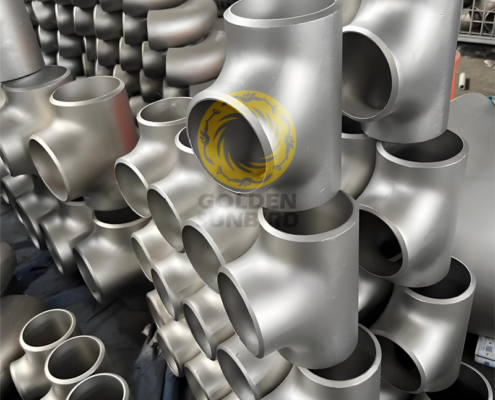Golden Sunbird Metals is a leading Chinese supplier of stainless steel pipe fittings available in different grades designed to meet the diverse needs of various industries for their corrosion resistance, high-temperature capability, and durability, serving critical roles in chemical processing, oil and gas, power generation, desalination plants, aerospace and defense, pharmaceutical manufacturing, and pulp and paper production. If you want to buy stainless steel pipe fittings in bulk or customized stainless steel pipe fittings, please get in touch with [email protected] for a tailored solution and quote.
FAQs
What types of Stainless Steel Pipe Fittings does Golden Sunbird Metals offer?
Golden Sunbird Metals specializes in producing and exporting various metal products, including stainless steel pipe fittings. Stainless steel pipe buttweld fittings are designed for permanent welding into a piping system. They are most commonly used with stainless steel pipes of the same grade to create a strong and leak-proof connection. Here are the most common types of stainless steel pipe buttweld fittings:
-
Elbows: These fittings change the direction of the pipe flow. They come in various degrees, most commonly being 90-degree and 45-degree elbows. They can also be short-radius or long-radius, with short-radius elbows having a tighter bend and long-radius elbows offering a smoother flow path.
-
Tees: These fittings have three openings, allowing a branch line to connect to a main running pipe. They come in various configurations, such as equal tees (all outlets have the same size) or reducing tees (one outlet has a different size).
-
Reducers: These fittings connect pipes of different diameters. They can be concentric reducers (smooth transition between diameters) or eccentric reducers (one side of the fitting is offset to accommodate uneven flow).
-
Caps: These fittings close off the end of a pipe run.
-
Stub Ends: These are short pieces of pipe with a machined bevel on one end for welding. They are used for various purposes, such as providing a welding surface for valves or instruments.
Here are some additional points to note about stainless steel pipe buttweld fittings:
-
Material Grade: For optimal corrosion resistance and compatibility, the fittings should be made from the same grade of stainless steel as the pipes.
-
Schedule: Similar to pipes, buttweld fittings can come in different schedules (wall thicknesses). The schedule should match the pipe wall thickness for a proper fit and pressure rating.
-
Standards: Buttweld fittings are manufactured according to industry standards, such as ASTM (American Society for Testing and Materials) specifications. These standards ensure consistent dimensions, material properties, and performance.
-
Size Designation: Buttweld fittings are typically sized by their nominal pipe size (NPS), corresponding to the outside diameter of the pipe they are designed for.
By understanding the different types and considerations for stainless steel pipe buttweld fittings, you can choose the appropriate fittings for your specific piping application.
How can I determine which stainless steel pipe fittings is right for my project?
Selecting the right stainless steel pipe fittings for your project involves considering several factors to ensure a safe, functional, and long-lasting piping system. Here’s a breakdown of the key aspects to evaluate:
1. Application and Purpose:
-
Fluid Type: The fluid conveyed through the pipes will influence the choice of fitting material. For example, some chemicals might require a specific grade of stainless steel to resist corrosion.
-
Pressure Rating: The pressure the piping system will operate under is crucial. For safety, choose fittings with a pressure rating equal to or exceeding the maximum system pressure.
-
Temperature: Consider the fluid’s operating temperature range. Some stainless steel grades might not be suitable for extremely high or low temperatures.
2. Fitting Type and Function:
-
Flow Direction: Identify how to change the flow direction within your pipe run. Elbows of various degrees (90°, 45°) or tees will be needed for direction changes or creating branch lines.
-
Pipe Diameters: Measure your pipes’ outer diameter (NPS) to ensure the fittings match correctly. If connecting pipes of different sizes, you might need reducers.
-
End Connection: Buttweld fittings require welding to the pipes for a permanent joint. Other fitting types, like flanges or compression fittings, might suit your needs (ease of assembly/disassembly, future maintenance).
3. Material Selection:
-
Stainless Steel Grade: Match the grade of stainless steel in the fittings to the grade of your pipes. This ensures compatibility and maintains consistent corrosion resistance throughout the system.
-
Schedule: Select a fitting schedule (wall thickness) that aligns with the schedule of your pipes. This ensures proper fit and maintains the intended pressure rating.
4. Standards and Regulations:
- For critical applications or applications with regulatory requirements, ensure the fittings comply with relevant industry standards, such as ASTM (American Society for Testing and Materials).
By carefully considering these factors and referring to manufacturer specifications, you can make informed decisions about selecting the most suitable stainless steel pipe fittings for your project.
Can Golden Sunbird Metals provide custom sizes for stainless steel pipe fittings?
Yes! Golden Sunbird Metals can provide custom sizes for stainless steel pipe fittings. It’s not very common and depends on several factors:
-
Complexity of the Fitting: Simple modifications to existing designs might be achievable, but highly customized or intricate shapes are likely more difficult and expensive.
-
Order Quantity: Custom fittings typically involve additional setup and machining processes. Manufacturers are more willing to accommodate custom requests for larger quantities to justify the extra setup costs.
-
Material Availability: Obtaining the specific grade and size of stainless steel material required for the custom fitting could be challenging.
-
Cost: Custom fittings will be significantly more expensive than standard-sized fittings due to the additional engineering, tooling, and production time involved.
What industries commonly use stainless steel pipe fittings?
Due to their durability, corrosion resistance, and ability to handle high temperatures, Stainless steel pipe fittings find application in a wide range of industries due to their durability, corrosion resistance, and ability to handle high temperatures. Here are some of the most common ones:
-
Chemical and Petrochemical Processing: This industry relies heavily on stainless steel pipes and fittings to transport various chemicals, fluids, and gases. They resist corrosion from harsh chemicals and can handle high pressures and temperatures commonly encountered in processing plants.
-
Oil and Gas Industry: Both onshore and offshore oil and gas exploration, transportation, and refining rely on stainless steel pipe fittings. Their strength and ability to withstand high pressure make them suitable for pipelines, well casings, and downhole tubing connections.
-
Food and Beverage Processing: Stainless steel’s smooth surface, ease of cleaning, and resistance to corrosion from food products make it ideal for food and beverage processing equipment. Pipe fittings connect pipes for transferring liquids like milk, beer, and juice and for sanitary piping systems.
-
Water and Wastewater Treatment: Water and wastewater treatment facilities utilize stainless steel pipe fittings due to their resistance to corrosion from chlorine and other chemicals used in the treatment process. They are also used in potable water distribution systems to ensure clean and safe drinking water.
-
Power Generation: In power plants, stainless steel pipe fittings connect pipes for transporting water, steam, and other fluids across the facility. Their high-temperature tolerance makes them suitable for nuclear power plants as well.
-
Pharmaceutical Industry: Like food processing, the pharmaceutical industry requires hygienic and corrosion-resistant materials. Stainless steel pipe fittings connect pipes to transfer pharmaceutical solutions and meet strict sanitary requirements.
-
Marine Industry: Due to their resistance to saltwater corrosion, stainless steel pipe fittings are used in shipbuilding and offshore applications. They can be found in piping systems for engines, ballast water, and other critical functions on ships and offshore platforms.
-
Construction and Architecture: Stainless steel pipe fittings are used in architectural applications for railings, support structures, and decorative elements. They are also used in building plumbing and HVAC systems.
Is your stainless steel pipe fittings environmentally friendly?
The environmental friendliness of stainless steel pipe fittings is a complex issue with both positive and negative aspects. Here’s a breakdown:
Positive Impacts:
- Durability and Longevity: Stainless steel fittings resist corrosion and last a long time. Fewer replacements are needed, reducing resource consumption and waste generation.
- Recyclability: Stainless steel is highly recyclable. End-of-life fittings can be recycled into new stainless steel products, minimizing reliance on virgin materials and their environmental impact.
- Low Maintenance: Stainless steel’s corrosion resistance minimizes the need for cleaning chemicals or coatings, reducing the environmental impact of such substances.
Negative Impacts:
- Manufacturing: Stainless steel production involves energy-intensive processes like high-temperature melting and forming, contributing to greenhouse gas emissions and environmental impact.
- Welding and Chromium Depletion: Welding can deplete chromium in the localized area around the weld, reducing corrosion resistance and potentially leading to earlier replacement. Proper welding techniques can help mitigate this issue.
Overall Assessment:
Stainless steel pipe fittings can be considered somewhat environmentally friendly. Their durability, recyclability, and low maintenance needs contribute positively. However, the energy used in manufacturing and potential chromium depletion during welding are negative factors.
Can stainless steel pipe fittings be welded or machined?
Yes, stainless steel pipe fittings can be both welded and machined, depending on the specific type of fitting and the desired outcome:
-
Welding: This is the most common method for connecting stainless steel pipe fittings to pipes. It creates a strong, permanent joint suitable for high-pressure applications. However, welding requires expertise to ensure proper penetration, minimize heat distortion, and avoid chromium depletion in the weld zone which can reduce corrosion resistance.
-
Machining: This process is typically used to modify or customize existing stainless steel pipe fittings. For instance, machining could create a threaded insert on a non-threaded fitting or adjust the dimensions slightly. Machining can also be used to create one-of-a-kind or custom fittings from solid stainless steel bar stock, but this is less common due to higher costs.
Here’s a table summarizing the key differences between welding and machining stainless steel pipe fittings:
| Feature | Welding | Machining |
| Purpose | Creating permanent joints between fittings and pipes | Modifying or customizing existing fittings |
| Typical Applications | High-pressure piping systems, permanent connections | Creating threaded inserts, adjusting dimensions, custom one-off fittings |
| Requirements | Expertise in welding stainless steel, proper equipment | Machining tools, knowledge of machining techniques |
| Resulting Joint | Permanent, strong joint | Modified or custom-fitting |
Additional Considerations:
-
Fitting Type: The type of fitting will influence whether welding or machining is more suitable. For instance, buttweld fittings are specifically designed for welding, while flanges might, depending on the design, be suitable for both welding and bolting.
-
Material Grade: The specific grade of stainless steel used in the fittings should be considered for welding and machining. Some grades might require specific welding or machining techniques to achieve optimal results.
-
Cost: Welding is generally less expensive than machining, especially for large quantities of fittings.
-
Project Requirements: The overall project requirements will dictate the most suitable method. For critical applications, welding by a qualified welder experienced in working with stainless steel is recommended.




